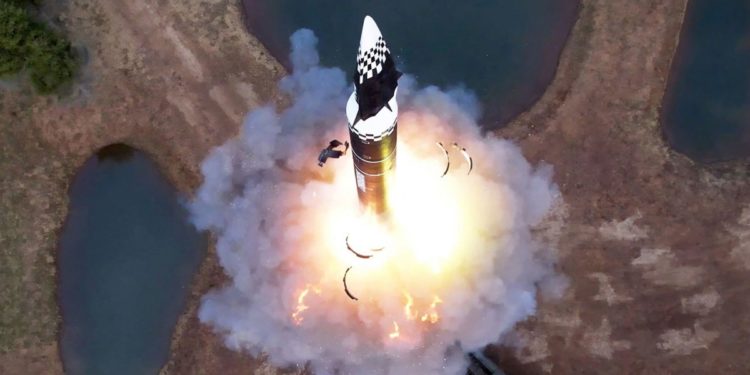During Tuesday’s test, the missile’s hypersonic glide warhead after being separated from the launch rocket reached a peak altitude of 62 miles and flew about 621 miles while performing various flight maneuvers before landing in waters between the Korean Peninsula and Japan, the KCNA said. The South Korean and Japanese militaries had assessed that the missile flew around 372 miles although Japan’s Defense Ministry announced a similar apogee with the North Korean report.
The North had also tested a purported hypersonic IRBM in January, which came years after it flight-tested liquid-fuel IRBMs. Experts say such weapons if perfected is potentially capable of reaching remote U.S. targets in the Pacific, including the military hub of Guam.
Kim Dong-yub, a professor at the University of North Korean Studies in Seoul, said the missile tested on Tuesday was likely different from the system tested in January, which state media didn’t name but would likely be the Hwasong-16A.
North Korea in previous tests have unveiled two different types of hypersonic vehicles — a conical one and a wedge-shaped one. State media images show that the January launch involved a conical warhead while the wedge-shaped design was used for Tuesday’s launch.
While North Korea had initially tested its hypersonic warheads with liquid-fuel systems, the ability to load them on solid-fuel rockets would allow for faster launches and operation, said Chang Young-keun, a missile expert at South Korea’s Research Institute for National Strategy.
“North Korea, in declaring that it has fully accomplished the nuclear weaponization of its missiles, also emphasized its commitment to arm its hypersonic missiles with nuclear weapons,” Chang said. “North Korea’s development of hypersonic IRBMs targets Guam, which hosts U.S. military bases, and even Alaska.”
Tensions in the region have risen since 2022 as Kim used Russia’s invasion of Ukraine as a distraction to accelerate his testing of missiles and other weapons. The United States and South Korea have responded by expanding their combined training and trilateral drills involving Japan and sharpening their deterrence strategies built around strategic U.S. assets.
While supervising Tuesday’s test, Kim Jong Un called for his country to further expand its nuclear and missile program to acquire “overwhelming power capable of containing and controlling” his enemies, who have “recently run higher fever in boosting their military alliance and staging all sorts of war drills.”
Hours after the launch, Seoul’s Defense Ministry announced that South Korea, the United States and Japan conducted a combined aerial exercise above waters near South Korea’s Jeju island that involved at least one nuclear-capable U.S. B-52 bomber.
The United States in recent months has been increasing its deployment of strategic assets to the region, also including aircraft carriers and missile-firing submarines, in a show of force against North Korea.
The post North Korea says it tested a new hypersonic intermediate-range missile that uses solid propellants appeared first on NBC News.

















